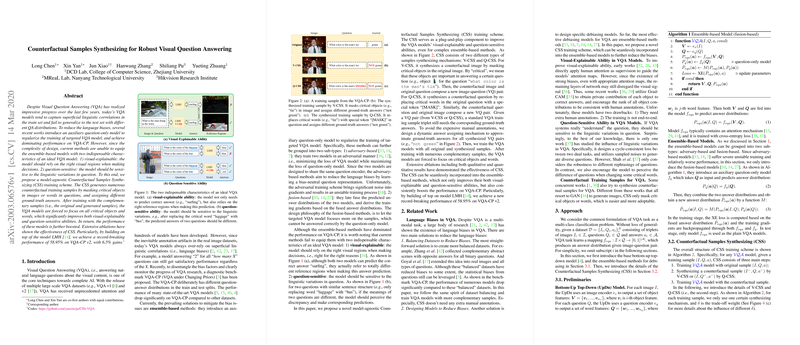Counterfactual Samples Synthesizing for Robust Visual Question Answering
Visual Question Answering (VQA) is a prominent task at the intersection of computer vision and natural language processing. Despite its rapid advancements, many VQA models are still hindered by their reliance on superficial linguistic cues, which limits their generalizability across datasets with different question-answer distributions. The paper "Counterfactual Samples Synthesizing for Robust Visual Question Answering" introduces a novel approach to address these limitations by employing a Counterfactual Samples Synthesizing (CSS) training scheme.
Methodology
The authors propose a model-agnostic approach, emphasizing the importance of generating counterfactual samples. These samples help models improve in two critical areas: visual-explanation and question-sensitivity. The CSS training scheme includes two core components: V-CSS (Visual Counterfactual Sample Synthesizing) and Q-CSS (Question Counterfactual Sample Synthesizing).
- Visual Counterfactual Sample Synthesizing (V-CSS): V-CSS works by modifying the visual components of a dataset, specifically through masking critical objects identified as important for a given question. This encourages models to rely on the relevant visual regions for answering questions.
- Question Counterfactual Sample Synthesizing (Q-CSS): This component targets linguistic variations in questions by replacing critical words with a masking token. By doing so, it ensures that the model remains sensitive to changes in the question's semantic meaning, thereby promoting a deeper understanding of the language component.
Through these processes, the VQA models are trained with augmented versions of the original dataset, which include both the original samples and the newly generated counterfactual samples. This dual presence ensures that the models are compelled to focus on both critical objects and words, resulting in an overall enhancement of their explanatory and descriptive capabilities.
Evaluation and Results
The effectiveness of the CSS training scheme is empirically validated through extensive experiments on various VQA models, including both simple and ensemble-based frameworks. Notably, when applied to the LMH model, the authors report significant improvements, achieving a record performance on the VQA-CP v2 dataset with an accuracy of 58.95%, marking a 6.5% gain over previous approaches.
The experiments also emphasize the versatility of the CSS approach, demonstrating improvements in both the visual-explainability and question-sensitivity of models. This is quantified through metrics that assess models' reliance on appropriate visual features and their ability to recognize and adapt to linguistic nuances in the questions.
Implications and Future Work
The CSS training scheme represents a meaningful step forward in enhancing the robustness and reliability of VQA models. By reducing their dependency on dataset-specific biases, these models become better equipped for practical, real-world applications where such biases often distort results. Furthermore, this work sets a precedent for incorporating counterfactual reasoning as a method to advance multimodal learning systems.
Looking ahead, the authors outline intentions to explore applications of CSS beyond VQA, targeting other visual-language tasks plagued by similar biases. Additionally, they aim to develop customized VQA architectures specifically designed to leverage the benefits offered by CSS.
In conclusion, this paper addresses fundamental limitations in current VQA systems by proposing an innovative training paradigm that enhances both their visual interpretability and linguistic depth, while also pushing the boundaries of model accuracy on benchmark datasets. Its contributions mark a substantial advance in the pursuit of more generalized and effective AI systems.
